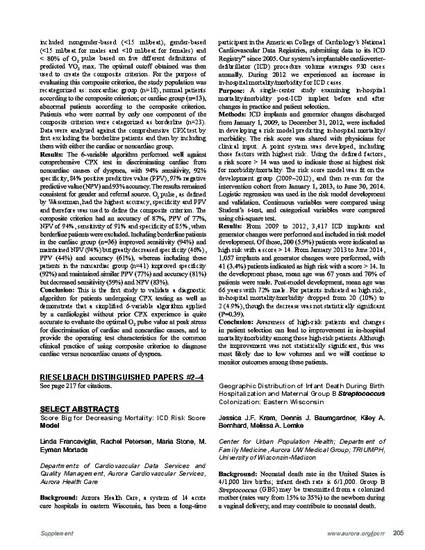
- GBS,
- colonization,
- infant death rate,
- geography
Background: Neonatal death rate in the United States is 4/1,000 live births; infant death rate is 6/1,000. Group B Streptococcus (GBS) may be transmitted from a colonized mother (rates vary from 15% to 35%) to the newborn during a vaginal delivery, and may contribute to neonatal death.
Purpose: To explore the geographic distribution and associated risk factors for maternal GBS colonization and infant death prior to discharge in eastern Wisconsin births.
Methods: Retrospective study of institutional data from PeriData.net, a comprehensive birth registry, utilizing data from 2007 through 2013 at all Aurora medical centers. Categorical variables were analyzed with chi-square tests, and ordinal or continuous variables by Mann-Whitney or two-sample t-tests. Binary regression was used for multivariate modeling.
Results: Population demographics (N = 99,305) were mean age 28 years, 59% married, 64% white, 42% government-insured, 39% nulliparous, mean prepregnancy body mass index (BMI) of 27, gestational age of 39 weeks, birth weight of 3,296 g and 26% C-section rate. The GBS colonization rate was 22.3%. Among ZIP codes with > 100 subjects, 8 ZIP codes had a GBS-positive rate > 30% (7 in Milwaukee, 1 in Kohler). GBS colonization was higher in blacks (34%) than whites (20%; P < 0.0001), in unmarried women (26% vs. 20%; P < 0.0001), with increasing BMI (mean BMI 27.3 if GBS-positive vs. 26.6; P < 0.0001) and based on ZIP code group (P < 0.0001); and was predictive of neonatal antibiotics for sepsis (26% if GBS-positive vs. 22%; P < 0.0001). In multivariate analysis, unmarried status, higher BMI, race and ZIP code were predictive of GBS colonization. Rate of infant death during birth hospitalization was 0.57% (n = 558) and varied by ZIP code group. GBS colonization was negatively associated with infant death (0.25% in GBS-positive vs. 0.66%; P < 0.0001; N = 98,065 with lethal anomalies and stillbirths excluded). This association remained when controlling for gestational age. In multivariate analysis, death rate was associated with one ZIP code group, no prenatal care, preterm labor, vaginal bleeding, hydramnios, oligohydramnios, lower gestational age and maternal GBS (negative predictor).
Conclusion: Geographic characteristics are associated with infant death during birth hospitalization and maternal GBS colonization. Demographic characteristics are only associated with maternal GBS colonization. It is unclear if maternal GBS colonization is “protective” against infant demise due to increased surveillance.
